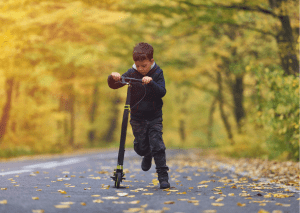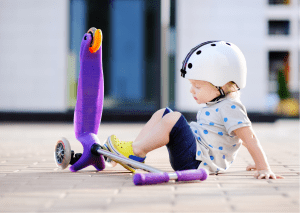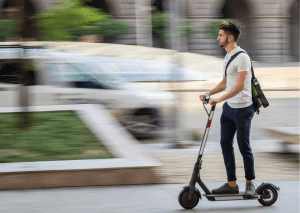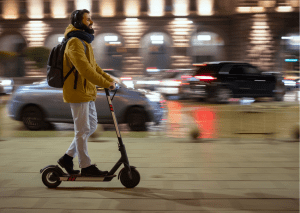As passionate electric scooters and bicycle enthusiasts, we understand the joy and freedom that comes from hitting the open road on two wheels.
It’s not just about knowing your electric scooter or bicycle and wearing a helmet, but also about understanding road regulations, mastering defensive riding techniques, and being prepared in case of emergency situations. We also need to consider the importance of rest stops, especially on longer journeys, and the added responsibility when carrying a passenger.

Therefore, whether you’re a seasoned electric scooter or just starting out, we’re here to guide you on how to ensure a fun and safe journey. We believe that by riding responsibly, wearing a helmet, and following guidelines, we not only protect ourselves but also contribute to the safety of other drivers, pedestrians, and cyclists on the road.
So let’s dive in and explore how to make our adventures safer and more enjoyable. Please share your feedback with us and help us spread the word about the right manner. We also invite organizations like the National Safety Council, the NHTSA, and the US Department of Transportation to join us in our mission to promote scooter and bicycle rules and protect our roads.
Key Takeaways
- Understanding the functionalities, limitations, and regular maintenance is crucial for safe riding.
- Planning the route, checking the weather forecast, and evaluating road conditions are important preparation steps.
- Adhering to road rules, maintaining a safe distance, and regularly scanning surroundings is essential.
- Regular brake maintenance, tire maintenance, and emergency preparedness are necessary.
Understanding Your Scooter
Before you set off on your journey, it’s critical that you thoroughly understand your scooter’s functionalities and limitations to ensure a safe and enjoyable journey.
Maintenance is a vital part of this understanding. We need to regularly check the brakes, tires, and lights. It’s essential to confirm that everything is in working order. This applies not just to vehicles but also to mopeds. Proper maintenance of these vehicles helps ensure their optimal performance.

Speed control is another crucial aspect. We must be aware of our maximum speed, and more importantly, understand that safe riding often means not pushing it to its limits. Doing so would keep us in control and prevent any unexpected mishaps. It’s always good to follow some essential tips to ensure a smooth ride.
As we prioritize our security and the well-being of others, let’s remember the importance of personal protection. Wearing the right gear, such as a helmet, protective clothing, and elbow pads, provides full protection in the event of a collision or fall. This commitment to safety not only benefits us but also the people around us.
So, whether you’re riding a scooter, moped, or any other two-wheeled vehicle, let’s prioritize safety by understanding our vehicle’s functionalities, performing regular maintenance checks, controlling our speed, and wearing the appropriate protective gear. By doing so, we can enjoy a safe and enjoyable journey while minimizing the risks associated with riding on the road.
Wearing The Right Body And Head Gear
Donning the appropriate attire isn’t just about looking cool – it’s a critical step in making sure you’re protected on your two-wheeled adventure. Helmet selection is vital. We caution against choosing style over yourself. Choose a helmet that fits snugly, meets the standards, and complies with local laws. It’s not just your head, but also your brain that we’re talking about here.
Now, let’s talk about protective clothing. It might be tempting to hop on your scooter in shorts and a T-shirt, but we strongly advise against this. Instead, choose pants, a sturdy jacket, and gloves. These will protect your skin in case of a crash and reduce the risk of serious injuries.
Let’s consider the importance of preparing our route and scooter maintenance. Remember, safety is more than just gear. It’s about being proactive and prepared. Familiarize yourself with the local traffic laws and regulations that apply to scooter riders. This knowledge will help you navigate the roads safely and avoid any legal issues.

Additionally, it’s worth noting that many of them have specific features designed to reduce the risk of crashes. Familiarize yourself with these features and ensure your scooter is well-maintained. Regularly check the brakes, tires, lights, and other essential components to ensure they are functioning properly.
By prioritizing safety through proper gear, knowledge of traffic laws, and regular maintenance, we can enjoy our scooter adventures while minimizing the risks associated with riding on two wheels. Stay safe and have a fantastic journey!
Preparing For The Exciting Journey
We’ll need to carefully plan our route, ensuring we’re familiar with the journey and any potential hazards along the way. It’s important to consider traffic laws and regulations that apply to everyone. Being aware of the rules of the road and any specific guidelines will help us navigate safely and responsibly.
And, of course, we need to check the weather reports, because nothing spoils it like an unexpected downpour. We need to be mindful of weather conditions that may affect visibility, road conditions, or our overall security. It’s wise to plan our routes during favorable weather and be prepared in case of any changes that may occur during the journey.
By taking the time to plan our route, abide by traffic laws, and stay informed about weather conditions, we can enjoy our experience while prioritizing protection. Let’s hit the road responsibly, just like responsible motorcycle riders, and make our adventures memorable and exciting.
Planning Your Way And Route
You’ll want to map out your route in detail, envisioning every twist and turn, ensuring it’s safe and friendly for your journey. We understand that this process can be intense, but it’s crucial for you and your overall journey experience.
- Identify Route Landmarks: Familiarize yourself with notable landmarks along your route. They can serve as checkpoints and reassurance that you’re on the right path.
- Consider Traffic Flow: Will your chosen route be congested during your travel time? If so, find alternate pathways that offer less traffic.
- Evaluate Road Conditions: Are the roads scooter-friendly? Avoid routes with potholes or rough surfaces that could cause accidents.
Remember, a well-planned route is the first step toward a safe and enjoyable experience.
Now, let’s shift our focus to the importance of checking the weather report.
Checking The Weather Forecast
Ever thought about how unpredictable weather can throw a spanner in your perfectly planned trip? It’s a reality we all have to face, especially when planning it. Checking the weather forecast is crucial in ensuring a fun and safe journey.

It allows us to anticipate seasonal impacts, adapt to the climate, and prepare accordingly. Rainy days could make roads slippery, while a hot sunny day could lead to fatigue and dehydration. Equipping ourselves with the right gear for the predicted weather is a smart move.
Remember that weather apps are our friends, providing hourly reports and severe weather alerts.
With the weather checked, we are ready to delve into the next crucial topic for a safe ride: understanding and following the road rules.
Road Safety Rules And Signs
Adhering to road safety rules isn’t just the law, it’s your ticket to a fun, worry-free adventure! Understanding the importance of traffic signals is crucial because they regulate the flow of vehicles and pedestrians, ensuring everyone’s safety. Using it in a city means we need to be vigilant about traffic signals and obey them diligently. Ignoring these signals can lead to accidents, so it’s vital to follow them and prioritize safety.
Respecting pedestrians is equally important. We must give right of way, especially at crosswalks, and maintain a safe distance when sharing the road with pedestrians. Interacting with pedestrians should be done courteously and attentively. Using flashing lights or a friendly wave can help communicate our intentions and make the road a safer place. Remember, scooters and pedestrians can coexist harmoniously when we show consideration and respect.
With these basic rules under our belts, we’re ready to delve into the next level of scooter safety: mastering defensive riding techniques! Understanding how to anticipate and react to potential hazards on the road can greatly enhance our protection. By staying alert, scanning the environment, and employing defensive riding tricks, such as maintaining a safe following distance and being prepared to react to sudden changes, we can minimize risks and enjoy a worry-free adventure.
So, let’s commit to adhering to road safety rules, respecting pedestrians, and mastering defensive riding techniques. By doing so, we can create a safer environment as it is needed by every road user, and make our journeys not just fun but also worry-free.
Defensive Riding Techniques To Learn
In our journey toward ensuring a fun and safe scooter ride, we’re going to dive into defensive riding techniques.

Let’s focus on how we can anticipate potential hazards and the importance of keeping a safe distance. By practicing defensive riding tips, we can develop the skills to proactively assess our surroundings and identify potential dangers. This includes scanning the road ahead, checking blind spots, and being aware of the movements of other vehicles.
Maintaining a safe distance from other vehicles is crucial. By keeping a buffer zone around us, we create more time and space to react to any sudden changes or unexpected situations that may arise. This extra space allows us to brake or maneuver safely and avoid potential collisions.
As we practice defensive riding techniques, it’s important to maintain a firm grip on the handlebars and stay alert. The handlebars provide us with control and stability, so it’s essential to have a comfortable and secure grip while riding. Additionally, staying focused on the road ahead and minimizing distractions will help us react swiftly to any potential hazards.
By incorporating these defensive riding techniques into our journeys, we can enhance our safety and ensure a more enjoyable experience. Remember, practice makes perfect, so let’s strive to continuously improve our skills and stay vigilant on the road.
Anticipating Potential Hazards
As you zip around, know some potential hazards like potholes, wet pavement, and unexpected traffic. Your safety depends largely on your Hazard Awareness and Risk Evaluation skills.
We recommend you to:
- Constantly scan your surroundings and anticipate any potential hazards.
- Evaluate the risk of each hazard and act accordingly to avoid it.
- Be aware of the behavior of other road users and anticipate their actions.
- Regularly check the condition to ensure it’s in top shape.
Remember, safety isn’t just about protecting ourselves, but also about ensuring we’re not posing a risk to others.
Keeping A Safe Distance
Keeping your distance might sound dull, but it’s your secret weapon against those unexpected mishaps on the road. We can’t stress enough the importance of maintaining a safe distance from other vehicles, particularly on long scooter rides.
This is where your understanding of traffic etiquette becomes a lifesaver. Wearing a helmet is a fundamental safety tip, but it’s also about adjusting your speed to the flow of traffic. When riding a scooter, giving ample space for others to maneuver not only helps you stay safe, it shows respect to every fellow road user. It’s always a good idea to be aware of your surroundings.
Part of keeping a safe distance also involves regular brake maintenance. Efficient brakes let us react swiftly to sudden stops or changes in traffic. Remember, we’re here to enjoy the journey, not risk our safety.
Handling Road Conditions
Handling road conditions or moped is a key part of ensuring a safe and enjoyable ride. Road conditions can vary widely, from smooth asphalt to rough, potholed streets. Two critical factors in handling these variances are tire maintenance and scooter suspension.
Tire maintenance is essential for maintaining traction and stability on the ground. Check your tires regularly for wear and tear, and make sure they’re properly inflated. Under-inflated tires can make your moped unstable, affecting your control and handling. On the other hand, over-inflation reduces grip, which can be equally dangerous. Keeping your tires in good condition and at the recommended pressure will help ensure a safer and smoother experience.
The suspension is equally important for handling different road conditions. It absorbs shocks from the ground, providing a more comfortable and controlled ride. Regularly inspect the suspension system for any signs of damage or wear, such as leaks or worn-out components. Maintaining proper suspension functionality will enhance your ability to navigate bumps, potholes, and other obstacles on the road.
Remember, when riding, it’s important to pay attention to the road and be aware of your surroundings, especially in areas where there may be pedestrians or children present. Adjust your speed accordingly and prioritize safety when sharing the road with others.
A great ride can quickly turn dangerous if you’re not prepared to handle unexpected road conditions. By maintaining your tires, inspecting the suspension, and staying alert to your surroundings, you can enhance your protection and ensure a more enjoyable riding experience. Let’s be responsible and make our journeys safer for everyone involved.
Scooter Emergency Preparedness
We know, it’s not something we like to think about, but it’s critical to be prepared in case of emergencies during your journeys. Having first aid training under your belt is invaluable in case of an accident. It could be the difference between a minor hiccup and a major catastrophe!
Remember to save emergency contacts in your phone and perhaps even write them down somewhere secure. In a pinch, it’ll be a relief to have these numbers readily available.
Besides dealing with potential injuries, being prepared also means handling mechanical issues. Carry a basic toolkit and familiarize yourself with common fixes.
After all, it is about more than just avoiding accidents; it’s about being ready to handle them when they occur. Up next, we’ll discuss the importance of taking regular breaks during your journey.
Importance Of Scooter Rest Stops
Don’t underestimate the power of a good rest stop! During your journeys, taking time to rest is critical for our enjoyment. It’s an opportunity to consider fatigue management, and the importance of hydration cannot be overstressed during these breaks.
- Find a safe spot to park and stretch.
- Keep a bottle of water handy in case of hydration.
- Snack on energy-boosting foods.
- Take a moment to check and know some issues.
- Use this time to plan the next leg of the journey.
Remember, it’s not just about the destination—it’s about the journey. Ensuring we’re well-rested and hydrated keeps us alert, so we can enjoy the journey and serve others better.
Now, let’s delve into how to safely enjoy our journey when we’re riding with a passenger.
Riding Scooters With A Passenger
When you’ve got a friend tagging along, there are a few extra considerations to keep in mind to make sure you both enjoy the trip and arrive at your destination without a hitch.

It’s crucial to prioritize passenger comfort, as discomfort can lead to distractions and potential risks. This includes ensuring your passenger has a secure seating area, providing them with proper gear, and regularly checking in on their wellbeing during the journey.
Communication methods are also essential when riding with a passenger. Establishing signals for needs like stopping or slowing down, and understanding each other’s comfort levels before setting off can make the journey smoother and safer.
Let’s also remember that it isn’t just about gear and precautions, but also about our behavior on the road. This brings us to our next topic, responsible riding.
Safe And Responsible Scooter Riding
It’s absolutely thrilling to feel the wind in your hair while zipping down the open road, but it’s just as important to remember that responsible riding is the cornerstone of every great trip. Rider etiquette isn’t just about being polite; it’s about ensuring the protection of everyone on the road. We must respect other drivers, give them space, and never assume they see us.
Investing in gear is crucial. A well-fitted helmet, protective clothing, and other equipment can significantly reduce the risk of injuries in case of an accident. Finding the right balance between comfort and safety is key when selecting gear.
Traffic signal adherence also plays a vital role in responsible riding. It’s not just about avoiding penalties; it’s about preventing accidents and ensuring a smooth journey. We must stop at red lights, proceed with caution at yellow signals, and proceed when green signals indicate it’s safe to do so. Following traffic signals helps maintain order on the road and minimizes the risk of collisions.
Always remember: our protection and that of others depend on our actions. Let’s make our journey not only fun but also safe by investing in proper safety gear, maintaining responsible etiquette, and adhering to traffic signals. By being responsible and considerate, we can enjoy the open road while keeping ourselves and others safe.
Conclusion
We’ve covered a lot, haven’t we? From understanding your scooter, gearing up right with the appropriate gear and clothing, and preparing for the journey, to observing road signs and highway safety, we’ve got you covered with the best riding tips.
We’ve also touched on emergency preparedness, rest stops, passenger scooter riding, and how to navigate railroad tracks safely. Responsible riding is a key theme that we’ve emphasized throughout.
The scooter industry is full of numerous brands, models, and styles, all of which provide a unique experience. It’s important to remember that safety is important, we want to make sure that everyone has a fun, memorable, and secure journey.
Let’s strive to make our journeys safe, enjoyable, and above all, responsible. Together, we can ensure a fantastic.
Frequently Asked Questions (FAQs):
Is a scooter good for long rides?
They are generally not ideal for long rides due to their limited range and battery life. They are more suitable for short commutes or urban travel where the distance is within their battery capacity.
What is the most safety scooter?
When it comes to safety, the most safety-focused scooters typically have features such as robust construction, reliable braking systems, good suspension, and integrated safety features like lights and reflectors for better visibility. Additionally, models with larger wheels and pneumatic tires tend to offer better stability and handling, which can contribute to overall safety.
Which is a safer scooter or a bike?
Their safety level is influenced by factors such as rider skill, adherence to traffic rules, road conditions, and the use of appropriate safety gear.
What is the disadvantage of a scooter?
One disadvantage of it is that they generally have smaller wheels, which can make them more susceptible to road hazards like potholes or uneven surfaces, potentially leading to instability or accidents.
Is A scooter Safer Than a car?
Comparing a scooter to a car, a car typically offers more protection in the form of a closed cabin, seat belts, airbags, and a more robust structure. However, scooters can still be safe if riders wear protective gear and follow traffic rules.
What are the advantages of scooters over bikes?
Advantages of scooters over bikes include better fuel efficiency, easier maneuverability in congested traffic, lower maintenance costs, and often more storage space.
What is scooter benefits?
It offer benefits such as improved fuel efficiency, reduced parking space requirements, and lower operating costs compared to larger vehicles like cars or motorcycles.
Is it safe to ride a scooter at night?
Riding it at night can be safe as long as the rider takes necessary precautions such as wearing reflective clothing, using proper lighting, and being extra cautious of other vehicles on the road.
Are scooters healthy?
Riding a scooter can have health benefits, as it provides physical activity and can contribute to increased cardiovascular fitness and improved core strength. However, it’s essential to maintain proper posture and use protective gear to minimize the risk of injury.
What injuries are caused by scooters?
Common injuries associated with scooter accidents include fractures, abrasions, head injuries, sprains, and strains. The severity of injuries can vary depending on factors like the speed of the scooter, impact force, and protective measures taken by the one using it.
Last Updated on July 21, 2023 by Harold Chan
DISCLAIMER (IMPORTANT): This information (including all text, images, audio, or other formats on FamilyHype.com) is not intended to be a substitute for informed professional advice, diagnosis, endorsement or treatment. You should not take any action or avoid taking action without consulting a qualified professional. Always seek the advice of your physician or other qualified health provider with any questions about medical conditions. Do not disregard professional medical advice or delay seeking advice or treatment because of something you have read here a FamilyHype.com.